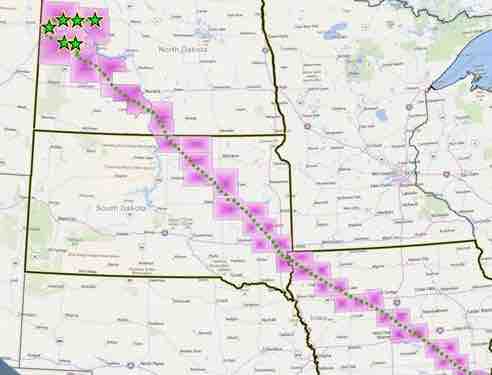Tribes' Battle over Dakota Access Pipeline Not Over

BISMARCK, N.D. (AP) — American Indian tribes fighting the $3.8 billion Dakota Access pipeline said Tuesday that the pumping of oil into the pipe under their water source is a blow, but it doesn’t end their legal battle. Industry groups say the imminent flow of oil through the pipeline is good news for energy and infrastructure.
The comments come after Texas-based developer Energy Transfer Partners said Monday that it has placed oil in a section of the pipeline under a Missouri River reservoir that’s upstream from the Standing Rock Indian Reservation in North Dakota. It was the final piece of construction for a pipeline that will carry crude from western North Dakota’s Bakken oil fields 1,200 miles (1930 kilometers) through South Dakota and Iowa to a distribution point near Patoka, Illinois. The pipeline should be fully operational in about three weeks, according to company spokeswoman Vicki Granado.
“We need to build pipelines, roads, rail and transmission lines to grow our economy and secure our nation’s energy future,” North Dakota Republican U.S. Sen. John Hoeven said.
Cheyenne River Sioux Chairman Harold Frazier said Sioux tribes in the Dakotas still believe they ultimately will persuade a judge to shut down the pipeline that they maintain threatens cultural sites, drinking water and religion.
“My people are here today because we have survived in the face of the worst kind of challenges,” he said. “The fact that oil is flowing under our life-giving waters is a blow, but it hasn’t broken us.”
Standing Rock Sioux Chairman Dave Archambault called oil under the lake “a setback, and a frightening one at that.” But he and Phillip Ellis, spokesman for the Earthjustice environmental law nonprofit, which is representing that tribe, said they are confident in the court case.
“The flow of oil under Lake Oahe is a temporary reminder of the pain this pipeline has perpetrated to those that have stood with Standing Rock and the devastation it has wreaked on sacred tribal sites, but hope remains,” Ellis said.
ETP maintains the pipeline is safe and disputes the tribes’ claims.
The legal battle isn’t confined to the Dakotas. In Iowa, the state chapter of the Sierra Club and a group of landowners are appealing a lawsuit challenging the pipeline to the Iowa Supreme Court. The crux of that dispute is whether the pipeline benefits the public in that state and whether the government was right to allow ETP to use eminent domain to obtain land for the project.
“Resistance is more than just the Lake Oahe crossing,” said environmental lawyer Carolyn Raffensperger, executive director of the Science and Environmental Health Network and chairwoman of the Iowa chapter of the Sierra Club.
ETP wrapped up construction on the pipeline this month after receiving permission from the U.S. government in February for the Lake Oahe work, which had been held up several months by protests and the legal dispute. The Army Corps of Engineers, which manages the Missouri River for the government, rescinded a planned environmental study that President Barack Obama’s administration had ordered and gave ETP permission to complete the pipeline at the urging of President Donald Trump.
“This is a public triumph for President Trump and his commitment to support U.S energy and economic development,” said Craig Stevens, spokesman for the MAIN Coalition, made up of agriculture, business and labor entities that benefit from Midwest infrastructure projects.
Ron Ness, president of the North Dakota Petroleum Council, a trade group that represents nearly 500 energy companies including ETP, said the pipeline will “have a significant impact on Bakken transportation going forward.”
North Dakota is the second-biggest oil producer in the U.S., after Texas. At capacity, the pipeline will be able to transport half of the state’s daily oil production of about 1 million barrels. Once the oil reaches Patoka, Illinois, it will be pumped into an existing pipeline that will take it to terminals in Texas, according to Granado, the ETP spokeswoman.
ETP has said in court documents that it has long-term transportation contracts with nine companies to ship oil through the pipeline. It could move enough oil to fill 500 or more railroad cars each day, according to the company. It is generally cheaper to move oil by pipeline than by rail, according to the U.S. Energy Information Administration.
Related News
Related News

- Enbridge Plans 86-Mile Pipeline Expansion, Bringing 850 Workers to Northern B.C.
- Intensity, Rainbow Energy to Build 344-Mile Gas Pipeline Across North Dakota
- Energy Transfer to Build $5.3 Billion Permian Gas Pipeline to Supply Southwest
- Enbridge Sees High Demand to Expand 593-Mile Canada-to-U.S. Gulf Oil Pipeline
- Strike Pioneers First-of-Its-Kind Pipe-in-Pipe Installation on Gulf Coast with Enbridge
- A Systematic Approach To Ensuring Pipeline Integrity
- 275-Mile Texas-to-Oklahoma Gas Pipeline Enters Open Season
- LNG Canada Start-Up Fails to Lift Gas Prices Amid Supply Glut
- Strike Pioneers First-of-Its-Kind Pipe-in-Pipe Installation on Gulf Coast with Enbridge
- Enbridge Sees High Demand to Expand 593-Mile Canada-to-U.S. Gulf Oil Pipeline




Comments